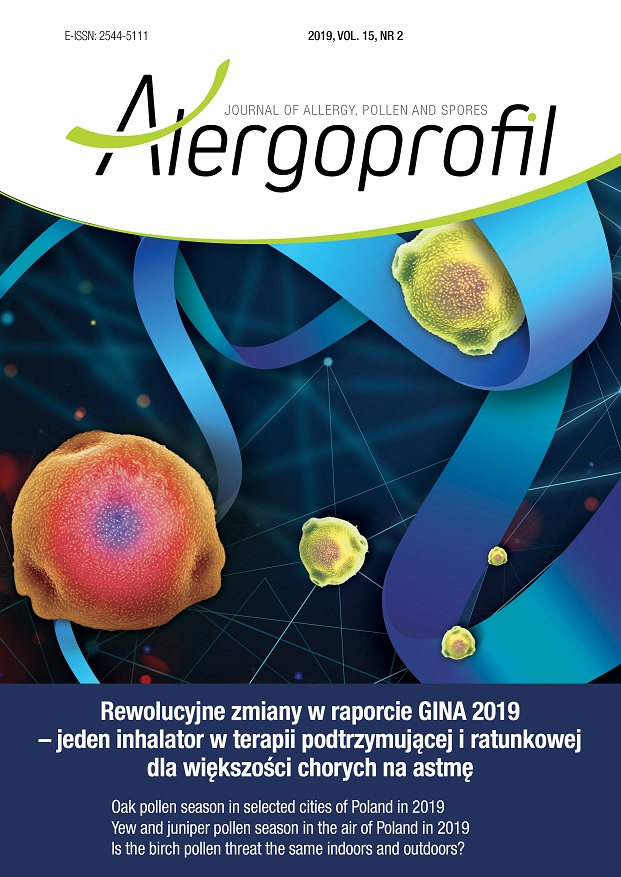Yew and juniper pollen season in the air of Poland in 2019
Main Article Content
Abstract
The study compares the yew and juniper pollen seasons in Bialystok, Bydgoszcz, Cracow, Katowice, Piotrkow Trybunalski, Opole, Szczecin, Zielona Gora, Warsaw, Wroclaw and Lublin in 2019. The investigations were carried out using the volumetric method (Hirst type pollen sampler). Seasonal Pollen Index (SPI) was estimated as the sum of daily average pollen concentrations in the given season. The yew pollination is mainly observed in February and March, while juniper pollination is mainly observed in March and April. Due to the morphological similarity of the pollen grains of both taxa, the pollen seasons of yew and juniper are considered together. The pollen season of yew/juniper started first in Szczecin, on the February 22nd. At the latest, a pollen season ended in Bialystok, Bydgoszcz, Zielona Gora, Warsaw and Lublin at the end April. The differences of pollen seasons duration were very considerable, from 20 to 63 days. The highest airborne concentration of 784 pollen grains/m3 was noted in Wroclaw on the March 7th. The maximum values of seasonal pollen count occurred between March 4th and 31st. The highest yew and juniper pollen allergen hazard occurred in 2019 in Lublin and Wroclaw and it was at least twice as high as other cities.
Downloads
Article Details

This work is licensed under a Creative Commons Attribution-NonCommercial 4.0 International License.
Copyright: © Medical Education sp. z o.o. This is an Open Access article distributed under the terms of the Attribution-NonCommercial 4.0 International (CC BY-NC 4.0). License (https://creativecommons.org/licenses/by-nc/4.0/), allowing third parties to copy and redistribute the material in any medium or format and to remix, transform, and build upon the material, provided the original work is properly cited and states its license.
Address reprint requests to: Medical Education, Marcin Kuźma (marcin.kuzma@mededu.pl)
References
2. Ziello Ch, Sparks TH, Estrella N et al. Changes to Airborne Pollen Counts across Europe. Plos One 2012. https://doi.org/10.1371/journal.pone.0034076.
3. Kaplan I, Holt P, Bousquet J, Kay A. Grass, tree, and weed pollen. Allergy and Allergic Diseases 2009, 2(1): 954-958.
4. D’Amato G, Spieksma FThM, Bonini S (eds). Allergenic Pollen and Pollinosis in Europe 1991, Blackwell Scientific Publ. 1991.
5. Ralska-Jasiewiczowa M, Latałowa M, Wasylikowa K et al. (eds). Late Glacial and Holocene history of vegetation in Poland based on isopollen maps. Polish Academy of Sciences, Cracow 2004.
6. Szczepanek K. Pollen calendar for Cracow (southern Poland), 1982-1991. Aerobiologia 1994, 10(1): 65-70.
7. Vanhaelen M, Duchateau J, Vanhaelen-Fastré R, Jaziri M. Taxanes in Taxus baccata pollen: cardiotoxicity and/or allergenicity? Planta Med 2002, 68(1): 36-40. https://doi.org/10.1055/s2002-19865.
8. Ogren T. The Allergy-Fighting Garden. Berkeley, CA 2015, Ten Speed Press: 205.
9. Burge HA. Monitoring for airborne allergens. Ann Allergy 1992, 69: 9-21.
10. Emberlin J, Savage M, Woodman R. Annual variations in the concentrations of Betula pollen in the London area 1961–1990. Grana 1993, 32: 359-363. https://doi.org/10.1080/00173139309428965.
11. Maguchi S, Fukuda S. Taxus cuspidata (Japanese yew) pollen nasal allergy. Auris Nasus Larynx 2001, 43-47. https://doi.org/10.1016/S0385-8146(01)00062-1.
12. Bunderson L, Luvall J, Water P, Levetin E. Juniper Pollen Hotspots in the Southwest. J Allergy Clin Immunol 2013, 131: 2. https://doi.org/10.1016/j.jaci.2012.12.954.
13. Kalinowska E, Lipiec A, Puc M et al. Analiza stężenia pyłku cisu/jałowca w wybranych miastach Polski w 2007 r. Alergoprofil 2007, 3(3): 55-60.
14. Puc M, Myszkowska D, Lipiec A et al. Pyłek cisa i jałowca w powietrzu wybranych miast Polski w roku 2009 r. Wpływ warunków pogodowych i zanieczyszczenia powietrza. Alergoprofil 2009, 5(2): 38-43.

